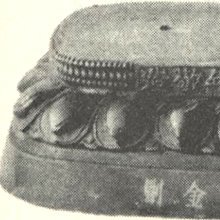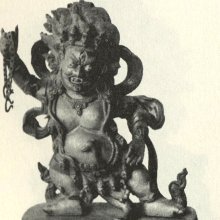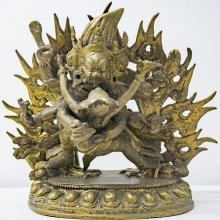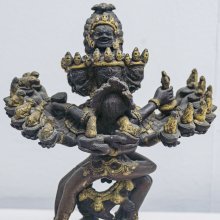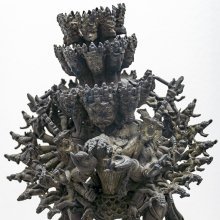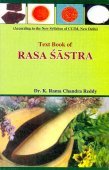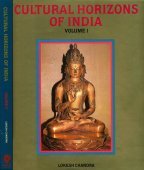Raga, Rāga, Ragā, Rāgā: 58 definitions
Introduction:
Raga means something in Buddhism, Pali, Hinduism, Sanskrit, Jainism, Prakrit, the history of ancient India, Marathi, Hindi, biology. If you want to know the exact meaning, history, etymology or English translation of this term then check out the descriptions on this page. Add your comment or reference to a book if you want to contribute to this summary article.
Images (photo gallery)
In Hinduism
Shaivism (Shaiva philosophy)
Source: Wisdom Library: ŚaivismRāga (राग):—Third of the five factors of limitation (kañcuka) that occur in the second stage during the unity of Śiva and Śakti (subject and object). Their unity is initiated upon the cosmic process of creation.
Source: bhagavadgitausa.com: Kashmir SaivismRāga: Siva is the Universal Consciousness with complete self-satisfaction (PUrnatva) so much so that He has no wants. But the individual soul lacks Purnatva and is full of unmet desires. The Supreme Will of Siva has the total Freedom to remain absolutely self-satisfied. This Freedom of Siva undergoes deformation in the individual embodied soul so much so the finite self seems to be in want all the time.
Source: McGill: The architectural theory of the Mānasāra (shaivism)Rāga (राग).—In the doctrine of Śaiva Siddhānta, rāga is one of the thirty-six tattvas, and connotes eros, the creative passion of the self that encompasses an entire range of emotions: desire, affection, delight, charm, joy.
Source: Brill: Śaivism and the Tantric TraditionsRāga (राग) refers to “desire” (which results in attachment), according to the Vārāṇasīmāhātmya verse 1.99ff.—Pulastya also reports that there is a pond there called Kālodaka, which arose when Kālarudra was playing on the cremation ground. At that time the Lord taught the observance of the skull (kapālavrata). He chopped off the fifth head of Brahmā, as a consequence of which there arose the holy Pāśupata pond. Mahādeva subsequently carries Brahmā’s skull around the world and unites with the cremation grounds. There he teaches that transmigration results from attachment (sneha), that attachment comes from desire (rāga), and that attachment is destroyed by indifference (vairāgya). When people attain indifference, their karma is destroyed and they attain unequalled happiness (saukhya). [...]

Shaiva (शैव, śaiva) or Shaivism (śaivism) represents a tradition of Hinduism worshiping Shiva as the supreme being. Closely related to Shaktism, Shaiva literature includes a range of scriptures, including Tantras, while the root of this tradition may be traced back to the ancient Vedas.
Ayurveda (science of life)
Dietetics and Culinary Art (such as household cooking)
Source: Shodhganga: Dietetics and culinary art in ancient and medieval IndiaRāga (राग) refers to a sweet liquid preparation from fruit juices, according to the Kaśyapasaṃhitā Kalpasthāna (Bhojana) 48, and is commonly found in literature dealing with the topics of dietetics and culinary art, also known as Pākaśāstra or Pākakalā.—We can see the description of flowering and fruit bearing plants in Ṛgveda. But we come across the specific names of them only in the later Saṃhita and Brāhmaṇa literature. [...] Kaśyapa refers to a sweet liquid preparation from the juice of sour fruits such as tamarind, rose apple, parūṣakā and Citrus medica which is known as rāga. Black mustard was used to make it pungent and sugar candy to sweeten it. Jellies prepared with fruit juices were called ṣāḍavas.
Toxicology (Study and Treatment of poison)
Source: Shodhganga: Kasyapa Samhita—Text on Visha ChikitsaRāga (राग) is the name of an ingredient used in the treatment (cikitsā) of immobile or plant poison (sthāvaraviṣa), according to the Kāśyapa Saṃhitā: an ancient Sanskrit text from the Pāñcarātra tradition dealing with both Tantra and Viṣacikitsā—an important topic from Āyurveda which deals with the study of Toxicology (Viṣavidyā or Sarpavidyā).—Sage Kāśyapa recommends potent drugs to treat sthāvara or plant-poison. According to the Kāśyapasaṃhitā (8.28), “The petals of Vahniśikhā, Vijaya, Rāga, a droṇa of the juice of Nirguṇḍī and Mātṛghāti (Lāṅgalī) powdered and made into a paste, with the latex of Snuhī which is an ativiṣa also effectively fights plant poison”.
Unclassified Ayurveda definitions
Source: Wisdom Library: Āyurveda and botanyRāga (राग):—A Sanskrit technical term referring to a “reddish” color of the skin, and is used throughout Ayurvedic literature such as the Caraka-saṃhitā and the Suśruta-saṃhitā. Rāga is a symptom (rūpa) considered to be due to involvement of pitta-doṣa (aggravated pitta).
Source: archive.org: Vagbhata’s Ashtanga Hridaya Samhita (first 5 chapters)1) Rāga (राग) refers to a type of food-preparation, as mentioned in verse 3.30 of the Aṣṭāṅgahṛdayasaṃhitā (Sūtrasthāna) by Vāgbhaṭa.—Accordingly, “[...] One shall eat rice (that is) white like jasmine [viz., kunda] and the moon, (together) with the meat of game. One shall drink broth (that is) not too thick, rasālā, curds, rāga and khāṇḍava syrup, [...]”.
Note: Rasālā, which denotes a certain kind of thick milk mixed with sugar and spices, has been rendered merely by źo (“curds”), evidently for lack of an adequate term. A similar reason accounts for the lengthy paraphrase of rāgakhāṇḍavau (written rāgaṣāḍabau in K) as bu-ram sbyar sogs gyos byas btuṅ phal-cher skyur-ba—“a potion (that is) concocted from treacle products etc. (and) preponderantly sour”, which led to the insertion of a supernumerary hemistich.—bu-rum in C is nothing but a mistake.
The best definition of rasālā, rāga, and khāṇḍava is given by Indu. Quoting from some unidentifiable source, he says:—“A decoction of grapes mingled with śāli-rice grits, charged with honey, combined with sugar and bamboo manna, enriched with a portion of treacle, seasoned with the three spices [mace, cardamom, cinnamon], (and) mixed with dhānya rice (is) to be known as rāga; (and) as ṣāḍaba (when it is in addition) acidulated with pomegranates."
2) Rāga (राग) refers to “(the urges of) passion”, mentioned in verse 4.25 of the Aṣṭāṅgahṛdayasaṃhitā.—Accordingly, “[...] He, however, who desires welfare both after his death and here shall always suppress the urges of avarice, jealousy, hatred, envy, passion [viz., lobha-īrṣyā-dveṣa-mātsarya-rāga], etc. after having subjugated his senses [viz., jitendriya]”.
Source: gurumukhi.ru: Ayurveda glossary of terms1) Rāga (राग):—Redness
2) Sweet sour sauce is prepared by using the juice of Vrksamla, Parusaka and jambu, added with little quantity of Mustard powder, sugar candy, Sauarcala and Saindhava lavana. Or a soft drinks prepared with drvyas of Madhura, amla and lavana rasa.
3) [rāgaḥ] Attachment : affection or sympathy for

Āyurveda (आयुर्वेद, ayurveda) is a branch of Indian science dealing with medicine, herbalism, taxology, anatomy, surgery, alchemy and related topics. Traditional practice of Āyurveda in ancient India dates back to at least the first millenium BC. Literature is commonly written in Sanskrit using various poetic metres.
Natyashastra (theatrics and dramaturgy)
Source: Google Books: Kalātattvakośa (nāṭya-śāstra)Rāga (राग).—In music, rāga has been said to have two forms, viz. nādamaya, i.e., made of sound which is the object of aural perception and the other devatāmaya which is to be realized through dhyāna (contemplation).
Source: Google Books: Music TherapyRāga (राग).—The 72 basic rāgas are actually a vyūha of 4 rāga associated with each of the original 18 jāti, (18x4=72). The subsequent generation is called putrarāga, or janyarāga (but literally speaking even the janakarāgas are jakarāgas from the 7 parents).
Source: archive.org: The Ragas Of Karnatic MusicRāga (राग).—The rāga delights the mind of the hearers by means of the excellence of svaras and varṇas and the different qualities of tone. The rāga is adorned by varṇas and svaras. The word rāga is derived from the root indicating the act of pleasing. Mataṅga adds that the word rāga has an etymological as well as a special or conventional meaning like the word paṅkaja.
Mataṅga enumerates the number of rāgas as follows:—5 cokṣās, 5 binnakas, 3 gauḍas, 8 rāgas, 7 sādhāraṇas, 16 bhāṣās and 12 vibhāṣās. Under each class he mentions rāgas with their names. (cf Mataṅga’s 9th century Bṛhaddeśī)
Puṇḍarīka Viṭhala in his Sadrāga-candrodaya expresses the view that Śiva divided the rāgas into three groups, viz:—
- śuddha, which are independent rāgas,
- sālaṅga, in which the colour of another rāga is found,
- saṅkīrṇa, which partaks the nature of the above two classes.
He says that the deśī-rāgas have been conceived by Hanumān as not bound by rigid rules.
Source: archive.org: Northern Indian Music Volume IRāga (राग, “mode”).—The notes (svara) which are to convey certain definite emotions or ideas must be carefully selected from the twenty-two intervals of the śruti scale and then grouped to form a mode, a rāga. Any artificially formed scale is not necessarily a rāga, for its meaning may be confused and without appeal. The essential feature of a rāga is its power of evoking an emotion that takes hold of the hearers like a spell.
According to Saṅgītadarpaṇa 2.1, “A rāga, the sages says, is a particular form of sound in which notes and melodic movements appear like ornaments and enchant the mind”.
Rāgas vary indefinitely. The number of rāgas theoretically possible is almost limitless. In practice, however, only a few hundred rāgas are generally used, but their classification is often confused, the same rāgas having different names in different provinces, and different rāgas the same name.
Source: WikiPedia: NatyashastraA raga is akin to a melodic mode in Indian classical music. In the context of ancient Indian music, the term refers to a harmonious note, melody, formula, building block of music available to a musician to construct a state of experience in the audience. Each raga is an array of melodic structures with musical motifs, considered in the Indian tradition to have the ability to "color the mind" and affect the emotions of the audience.
A raga consists of at least five notes, and each raga provides the musician with a musical framework. The specific notes within a raga can be reordered and improvised by the musician, but a specific raga is either ascending or descending. The raga is considered a means in Indian musical tradition to evoke certain feelings in an audience. Hundreds of raga are recognized in the classical Indian tradition, of which about 30 are common.

Natyashastra (नाट्यशास्त्र, nāṭyaśāstra) refers to both the ancient Indian tradition (shastra) of performing arts, (natya—theatrics, drama, dance, music), as well as the name of a Sanskrit work dealing with these subjects. It also teaches the rules for composing Dramatic plays (nataka), construction and performance of Theater, and Poetic works (kavya).
Purana and Itihasa (epic history)
Source: archive.org: Puranic EncyclopediaRāgā (रागा).—One of the seven daughters of Bṛhaspati—Aṅgiras. As she was loved by all beings she came to be called Rāgā. (Vana Parva, Chapter 203).
Source: Cologne Digital Sanskrit Dictionaries: The Purana IndexRāga (राग).—Carries away bhūta; leads to saṃsāra and its ills; Viṣayarāga, reason for re-birth.*
- * Vāyu-purāṇa 102. 67, 69.

The Purana (पुराण, purāṇas) refers to Sanskrit literature preserving ancient India’s vast cultural history, including historical legends, religious ceremonies, various arts and sciences. The eighteen mahapuranas total over 400,000 shlokas (metrical couplets) and date to at least several centuries BCE.
Vedanta (school of philosophy)
Source: WikiPedia: UpanishadsRāga (राग).—The Mundaka Upanishad uses it in its discussion of soul (Atman-Brahman) and matter (Prakriti), with the sense that the soul does not “color, dye, stain, tint” the matter. The Maitri Upanishad uses the term in the sense of “passion, inner quality, psychological state”.
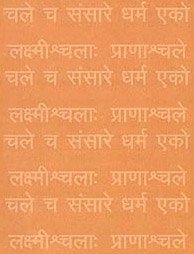
Vedanta (वेदान्त, vedānta) refers to a school of orthodox Hindu philosophy (astika), drawing its subject-matter from the Upanishads. There are a number of sub-schools of Vedanta, however all of them expound on the basic teaching of the ultimate reality (brahman) and liberation (moksha) of the individual soul (atman).
Vastushastra (architecture)
Source: McGill: The architectural theory of the MānasāraRāga (राग).—The word rāga derives from √ranj, “ta glow”, and also “to be affected, excited”. In art, rāga is the color crimson, and in music, particular musical modes that excite particular affections.
According to the Mānasāra LXX, 10-11: “The internal and external rāga as well as wealth will be destroyed, no doubt, having wrongly done the liberation of the eye; also certainly will be contacted disease of the eye”. In the above verse, Acharya, translates rāga as “light (i.e. sight)”. For the sthapati, rāga, together with kalā, here to me an “aptitude”, and vidyā, “knowledge” constitute the key principles of creativity. Loss of rāga thus implies the very deprivation of passion and imagination for artistic creation.
The text mentions two kinds of rāga: internal and external. Taken in the sense of a passionate vision or “seeing”, it is by engaging both the internal and external aspects of rāga that architectural and iconographie making proceeds. For the sthapati, building the temple and making the image are, so to speak, the process of “seeing” it into being. “Seeing” in artistic and architectural making encompasses interaction with the material world through perception and observation, and exploration of the inner realm by imagination and conception.
Rāga is fully realized by observing the rules. Making sense of the architectural theory propounded in the vāstuśastra of the Mānasāra, amounts to, at the primary level, this apprehension of the indefeasible link by way of identification between “seeing” and “knowing”: the ontological (or, to be more accurate, onto-theological) premise of “seeing-as-knowing”, as well as its epistemological converse of “knowing-as-seeing”.

Vastushastra (वास्तुशास्त्र, vāstuśāstra) refers to the ancient Indian science (shastra) of architecture (vastu), dealing with topics such architecture, sculpture, town-building, fort building and various other constructions. Vastu also deals with the philosophy of the architectural relation with the cosmic universe.
Shaktism (Shakta philosophy)
Source: Wisdom Library: ŚāktismRāga (राग) refers to one of the 53 gods to be worshipped in the western quarter and given pāyasa (rice boiled in milk) according to the Vāstuyāga rite in Śaktism (cf. Śāradātilaka-tantra III-V). The worship of these 53 gods happens after assigning them to one of the 64 compartment while constructing a Balimaṇḍapa. Vāstu is the name of a prodigious demon, who was killed by 53 gods (e.g., Rāga).
Source: Google Books: ManthanabhairavatantramRāga (राग) refers to “attachment”, according to the Manthānabhairavatantra, a vast sprawling work that belongs to a corpus of Tantric texts concerned with the worship of the goddess Kubjikā.—Accordingly, “(A true practitioner) is a hero (vīra) who exerts himself and is courageous. [...] He is always content and is loved by the Yoginīs. He is free of attachment, aversion [i.e., rāga-dveṣa-vinirmukta] and ego. He is loved by his (spiritual) clan (svagotra). He is wise and he observes the Rules. He is the joy of those who are devoted to him and always does what he promises to do. He who has these characteristics is an accomplished soul (siddha) (already) in his previous life. Otherwise he is not a Siddha and his tradition is not Kaula”.

Shakta (शाक्त, śākta) or Shaktism (śāktism) represents a tradition of Hinduism where the Goddess (Devi) is revered and worshipped. Shakta literature includes a range of scriptures, including various Agamas and Tantras, although its roots may be traced back to the Vedas.
Vaishnavism (Vaishava dharma)
Source: Pure Bhakti: Bhagavad-gita (4th edition)Rāga (राग) refers to “(1) Deep attachment for Kṛṣṇa, permeated by spontaneous and intense absorption in the object of one’s affection (2) A deep and overpowering thirst for the object of one’s affection”. (cf. Glossary page from Śrīmad-Bhagavad-Gītā).
Source: Pure Bhakti: Brhad BhagavatamrtamRāga (राग) refers to:—Deep attachment for the object of one’s affection. (cf. Glossary page from Śrī Bṛhad-bhāgavatāmṛta).

Vaishnava (वैष्णव, vaiṣṇava) or vaishnavism (vaiṣṇavism) represents a tradition of Hinduism worshipping Vishnu as the supreme Lord. Similar to the Shaktism and Shaivism traditions, Vaishnavism also developed as an individual movement, famous for its exposition of the dashavatara (‘ten avatars of Vishnu’).
Jyotisha (astronomy and astrology)
Source: Wisdom Library: Brihat Samhita by VarahamihiraRāga (राग) refers to a “color”, according to the Bṛhatsaṃhitā (chapter 12), an encyclopedic Sanskrit work written by Varāhamihira mainly focusing on the science of ancient Indian astronomy astronomy (Jyotiṣa).—Accordingly, “If the disc of the star Canopus (Agastya) should present a disagreeable appearance, there will be disease in the land; if yellow, there will be drought; if of the colour of smoke, cows will suffer; if of unsteady light, mankind will be afflicted with fears; if white red [i.e., māñjiṣṭha-rāga-sadṛśa], they will suffer from hunger and from starvation; and if of very small disc, the chief towns will be surrounded by the enemy.”.

Jyotisha (ज्योतिष, jyotiṣa or jyotish) refers to ‘astronomy’ or “Vedic astrology” and represents the fifth of the six Vedangas (additional sciences to be studied along with the Vedas). Jyotisha concerns itself with the study and prediction of the movements of celestial bodies, in order to calculate the auspicious time for rituals and ceremonies.
Kama-shastra (the science of Love-making)
Source: Brill: Śaivism and the Tantric Traditions (kāmasūtra)Rāga (राग) refers to “passion”, according to the Kāmasūtra of Vātsyāyana and Jaśodhara’s commentary called the Jayamaṅgalā .—Accordingly, “[When you are] about to practise sex, [first you should] rub her genitalia with your hand, and when there is dampness, the sexual act can be commenced. This is the restoration of passion (rāga-pratyānayana)”.
Source: Shodhganga: Elements of Art and Architecture in the Trtiyakhanda of the Visnudharmottarapurana (kama)Rāga (राग) refers to “colours”.—Cf. Maṇirāgākarajñāna which refers to “knowledge of jewel, colours and mines”, representing one of the “sixty four kinds of Art”, according to the Kāmasūtra of Vātsyāyaṇa.—Indian tradition, basically includes sixty four Art forms are acknowledged. The references of sixty four kinds of kalā are found in the Bhāgavatapurāṇa, Śaiva-Tantras, Kāmasūtra of Vātsyāyaṇa etc.
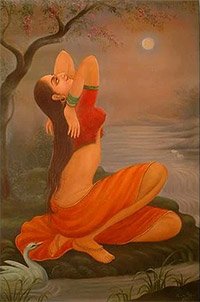
Kamashastra (कामशास्त्र, kāmaśāstra) deals with ancient Indian science of love-making, passion, emotions and other related topics dealing with the pleasures of the senses.
Ganitashastra (Mathematics and Algebra)
Source: archive.org: Hindu MathematicsRāga (राग) represents the number 6 (six) in the “word-numeral system” (bhūtasaṃkhyā), which was used in Sanskrit texts dealing with astronomy, mathematics, metrics, as well as in the dates of inscriptions and manuscripts in ancient Indian literature.—A system of expressing numbers by means of words arranged as in the place-value notation was developed and perfected in India in the early centuries of the Christian era. In this system the numerals [e.g., 6—rāga] are expressed by names of things, beings or concepts, which, naturally or in accordance with the teaching of the Śāstras, connote numbers.

Ganitashastra (शिल्पशास्त्र, gaṇitaśāstra) refers to the ancient Indian science of mathematics, algebra, number theory, arithmetic, etc. Closely allied with astronomy, both were commonly taught and studied in universities, even since the 1st millennium BCE. Ganita-shastra also includes ritualistic math-books such as the Shulba-sutras.
General definition (in Hinduism)
Source: WikiPedia: HinduismRāga (राग), states Monier Monier-Williams, comes from a Sanskrit word for “the act of colouring or dyeing”, or simply a “colour, hue, tint, dye”. The term also connotes an emotional state referring to a “feeling, affection, desire, interest, joy or delight”, particularly related to passion, love, or sympathy for a subject or something
In Buddhism
Theravada (major branch of Buddhism)
Source: Access to Insight: A Glossary of Pali and Buddhist TermsLust; greed. See lobha.Source: Pali Kanon: Pali Proper NamesOne of Maras three daughters, who sought to tempt the Buddha.
SN. vs. 835; S.i.124ff.; J.i.78; DhA.i.201; iii.196,199, etc.
Source: Pali Kanon: Manual of Buddhist Terms and Doctriness. Rāga (“Lust”).
Source: Pali Kanon: Manual of Buddhist Terms and Doctrines'lust', 'greed', is a synonym of lobha (s. mūla), tanhā and abhijjhā (s. kammapatha).
For kāma-, rūpa-, arūpa-rāga, s. samyojana.
Theravāda is a major branch of Buddhism having the the Pali canon (tipitaka) as their canonical literature, which includes the vinaya-pitaka (monastic rules), the sutta-pitaka (Buddhist sermons) and the abhidhamma-pitaka (philosophy and psychology).
Mahayana (major branch of Buddhism)
Source: Wisdom Library: Maha Prajnaparamita Sastra1) Rāga (राग) refers to one of the three daughters of Māra mentioned in the 2nd century Mahāprajñāpāramitāśāstra (chapter XXIV).—Accordingly, “While the Buddha was under the Bodhi tree, king Māra, out of spite (daurmanasya) sent him the three princesses, Lo kien (Ragā), Yue pei (Arati) and K’o ngai (Tṛṣṇā). They came showing off their bodies and using all sorts of charms to try to corrupt the Bodhisattva, but the latter did not let himself become disturbed and did not look at them”.
2) Rāga (राग, “desire”) refers to one of the three poisons (triviṣa) according to Mahāprajñāpāramitāśāstra (chapter LII).—Desire is of two kinds:
- bad desire (mithyārāga)
- and simple desire
Rāga (राग) (Cf. Sarāga) refers to “passion”, according to the Gaganagañjaparipṛcchā: the eighth chapter of the Mahāsaṃnipāta (a collection of Mahāyāna Buddhist Sūtras).—Accordingly, “Son of good family, how does the knowledge (jñāna) of the Bodhisattva becomes like open space? (1) Having pervaded the thoughts of all beings by knowledge, he knows the impassioned thought of all beings truly as it is, as an impassioned thought (sarāga-citta—api sarāgaṃ cittaṃ); (2) he knows the thought full of aversion truly as it is, as a thought full of aversion; (3) he knows the thought full of bewilderment truly as it is, as a thought full of bewilderment; (4) he knows the thought full of impurity truly as it is, as a thought full of impurity; (5) he never deviates from the nature of the dharma which is without desire, and teaches the dharma for other beings so that they overcome their desire;

Mahayana (महायान, mahāyāna) is a major branch of Buddhism focusing on the path of a Bodhisattva (spiritual aspirants/ enlightened beings). Extant literature is vast and primarely composed in the Sanskrit language. There are many sūtras of which some of the earliest are the various Prajñāpāramitā sūtras.
Tibetan Buddhism (Vajrayana or tantric Buddhism)
Source: archive.org: The Indian Buddhist IconographyRāga (राग, “attachment”) refers to one of the five Kulas (families), according to Guhyasamāja.—[...] The families (kula) owe allegiance to their progenitors who are known as Kuleśas or Lords of Families. In the Guhyasamāja it is said: “The five Kulas (families) are the Dveṣa (hatred), Moha (delusion), Rāga (attachment), Cintāmaṇi (Wishing Gem), and Samaya, (convention) which conduce to the attainment of all desires and emancipation”.
Source: academia.edu: The Structure and Meanings of the Heruka Maṇḍala1) Rāgā (रागा) is the name of a Ḍākinī who, together with the Vīra (hero) named Rāga forms one of the 36 pairs situated in the Jñānacakra, according to the 10th century Ḍākārṇava chapter 15. Accordingly, the jñānacakra refers to one of the three divisions of the saṃbhoga-puṭa (‘enjoyment layer’), situated in the Herukamaṇḍala. The 36 pairs of Ḍākinīs [viz., Rāgā] and Vīras are white in color; the shapes of their faces are in accordance with their names; they have four arms; they hold a skull bowl, a skull staff, a small drum, and a knife.
2) Rāga (राग) is also the name of a Vīra (hero) who, together with the Ḍākinī named Rāgī forms one of the 36 pairs situated in the Cittacakra, according to the same work. Accordingly, the cittacakra refers to one of the three divisions of the nirmāṇa-puṭa (‘emanation layer’), situated in the Herukamaṇḍala. The 36 pairs of Ḍākinīs and Vīras [viz., Rāga] are black in color; they each have one face and four arms; they hold a skull bowl, a skull staff, a small drum, and a knife.
Source: OSU Press: Cakrasamvara SamadhiRāga (राग, “passion”) refers to one of the “five afflictions” (pañcakleśa), according to the Saṃvaramaṇḍala of Abhayākaragupta’s Niṣpannayogāvalī, p. 45 and n. 145; (Cf. Cakrasaṃvaratantra, Gray, David B., 2007).—The tiger skin (vyāghracarma) symbolizes a fully developed Yogī, able to route the Buddhist devil Māra, and save those overcome by the Pañcakleśa, "The Five Afflictions", (the Mahāyāna version of the Triviṣa, "Three Poisons"). 1) moha, "delusion", 2) rāga, "passion", 3) dveṣa, "hatred", 4) māna, "pride", 5) īrṣyā, "jealousy.

Tibetan Buddhism includes schools such as Nyingma, Kadampa, Kagyu and Gelug. Their primary canon of literature is divided in two broad categories: The Kangyur, which consists of Buddha’s words, and the Tengyur, which includes commentaries from various sources. Esotericism and tantra techniques (vajrayāna) are collected indepently.
General definition (in Buddhism)
Source: Wisdom Library: Dharma-samgrahaRāga (राग, “passion”) refers to one of the “six defilements” (kleśa) as defined in the Dharma-saṃgraha (section 67). The Dharma-samgraha (Dharmasangraha) is an extensive glossary of Buddhist technical terms in Sanskrit (e.g., rāga). The work is attributed to Nagarjuna who lived around the 2nd century A.D.
Source: WikiPedia: BuddhismRāga (राग) is also found in ancient texts of Buddhism where it connotes “passion, sensuality, lust, desire” for pleasurable experiences as one of three impurities of a character. Alternatively, rāga is used in Buddhist texts in the sense of “color, dye, hue”.
In Jainism
Jain philosophy
Source: archive.org: Anekanta Jaya Pataka of Haribhadra SuriRāga (राग) refers to “attachment”, as used in the Anekāntajayapatākā-prakaraṇa, a Śvetāmbara Jain philosophical work written by Haribhadra Sūri.—[Cf. Vol. I, P. 1, l. 10.]—‘Rāga’ means ‘attachment’, and its complete destruction implies that of dveṣa (aversion), too.
-
General definition (in Jainism)
Source: archive.org: TrisastisalakapurusacaritraRaga (रग) refers to “love”, according to chapter 6.2 [aranātha-caritra] of Hemacandra’s 11th century Triṣaṣṭiśalākāpuruṣacaritra: an ancient Sanskrit epic poem narrating the history and legends of sixty-three illustrious persons in Jainism.
Accordingly, as Ara said in his sermon on rāga and dveṣa:—“[...] People who are led by a mind whose knowledge has been destroyed by the darkness of love, etc., fall into hell like a blind man, led by a blind man, into a well. Passion (rati) for and joy (prīti) in objects, etc., are called love (raga); the wise call dislike (arati) and discontent (aprīti) with these same objects hate (dveṣa). These two, very powerful, a bond for all people, are known as the root and bulb of the tree of all pains. Who would be open-eyed with astonishment in happiness, who would be pitiable in sorrow, who would fail to reach emancipation, if there were no love and hate here? [...]”.

Jainism is an Indian religion of Dharma whose doctrine revolves around harmlessness (ahimsa) towards every living being. The two major branches (Digambara and Svetambara) of Jainism stimulate self-control (or, shramana, ‘self-reliance’) and spiritual development through a path of peace for the soul to progess to the ultimate goal.
India history and geography
Source: Cologne Digital Sanskrit Dictionaries: Indian Epigraphical GlossaryRāga.—(IE 7-1-2), ‘six’. Note: rāga is defined in the “Indian epigraphical glossary” as it can be found on ancient inscriptions commonly written in Sanskrit, Prakrit or Dravidian languages.

The history of India traces the identification of countries, villages, towns and other regions of India, as well as mythology, zoology, royal dynasties, rulers, tribes, local festivities and traditions and regional languages. Ancient India enjoyed religious freedom and encourages the path of Dharma, a concept common to Buddhism, Hinduism, and Jainism.
Biology (plants and animals)
Source: Google Books: CRC World Dictionary (Regional names)Raga in India is the name of a plant defined with Abies spectabilis in various botanical sources. This page contains potential references in Ayurveda, modern medicine, and other folk traditions or local practices It has the synonym Picea webbiana Loudon (among others).
Example references for further research on medicinal uses or toxicity (see latin names for full list):
· Fl. Berlin (1824)
· Species Plantarum
· Penny Cyclop. (1833)
· A Description of the Genus Pinus, ed. 2 (1828)
· Hist. Nat. des Végétaux - Phanérogames (1841)
· Flora Reipublicae Popularis Sinicae (1978)
If you are looking for specific details regarding Raga, for example health benefits, extract dosage, pregnancy safety, chemical composition, side effects, diet and recipes, have a look at these references.

This sections includes definitions from the five kingdoms of living things: Animals, Plants, Fungi, Protists and Monera. It will include both the official binomial nomenclature (scientific names usually in Latin) as well as regional spellings and variants.
Languages of India and abroad
Pali-English dictionary
Source: BuddhaSasana: Concise Pali-English Dictionaryrāga : (m.) colour; hue; dye; lust; attachment.
Source: Sutta: The Pali Text Society's Pali-English DictionaryRāga, (cp. Sk. rāga, fr. raj: see rajati) 1. colour, hue; colouring, dye Vin. II, 107 (aṅga° “rougeing” the body: bhikkhū aṅgarāgaṃ karonti); ThA. 78; SnA 315 (nānāvidha°).—2 (as t. t. in philosophy & ethics) excitement, passion; seldom by itself, mostly in combination with dosa, & moha, as the three fundamental blemishes of character: passion or lust (uncontrolled excitement), ill-will (anger) and infatuation (bewilderment): see dosa2 & moha; cp. sarāga.—These three again appear in manifold combinations with similar terms, all giving var. shades of the “craving for existence” or “lust of life” (taṇhā etc.), or all that which is an obstacle to nibbāna. Therefore the giving up of rāga is one of the steps towards attaining the desired goal of emancipation (vimutti).—Some of the combinations are e.g. the 3 (r. d. m.)+kilesa; +kodha; very often fourfold r. d. m. with māna, these again with diṭṭhi: see in full Nd2 s. v. rāga (p. 237), cp. below ussada.—Of the many passages illustrating the contrast rāga›nibbāna the foll. may be mentioned: chandarāga vinodanaṃ nibbānapadaṃ accutaṃ Sn. 1086; yo rāgakkhayo (etc.): idaṃ vuccati amataṃ S. V, 8; yo rāgakkhayo (etc.): idaṃ vuccati nibbānaṃ S. IV, 251; ye ‘dha pajahanti kāmarāgaṃ bhavararāganu-sayañ ca pahāya ... parinibbāna-gatā Vv 5324; kusalo jahati pāpakaṃ ... rāga dosa-mohakkhayā parinibbuto Ud. 85.—Personified, Rāga (v. l. Ragā), Taṇhā & Arati are called the “daughters of Māra” (Māradhītā): Sn. 835; DhA. III, 199; Nd1 181.—For further detail of meaning & application see e. g.—(1) with dosa & moha: D. I, 79, 156; III, 107, 108, 132; S. I, 184; IV, 139, 195, 250, 305; V, 84, 357 sq.; M. II, 138 (rasa° the excitement of taste); A. I, 52, 156 sq. , 230 sq.; II, 256; III, 169, 451 sq.; IV, 144; It. 56, 57; Vism. 421; VbhA. 268, 269 (sa° & vīta°).—(2) in other connection: D. III, 70, 74, 146, 175, 217, 234 (arūpa°), 249 (cittaṃ pariyādāya tiṭṭhati); S. II, 231=271 (cittaṃ anuddhaṃseti); III, 10; IV, 72, 329; V, 74 (na rāgaṃ jāneti etc.); A. II, 149 (tibba-rāga-jātiko rāgajaṃ dukkhaṃ paṭisaṃvedeti); III, 233, 371 (kāmesu vīta°); IV, 423 (dhamma°); Sn. 2, 74, 139, 270=S. I, 207 (+dosa); Sn. 361, 493, 764, 974, 1046; Dh. 349 (tibba°= bahala-rāga DhA. IV, 68); Ps. I, 80 sq.; II, 37 (rūpa°), 95 (id.); Vbh. 145 sq. (=taṇhā), 368 (=kiñcana), 390; Tikp 155, 167; DA. I, 116.—Opp. virāga.

Pali is the language of the Tipiṭaka, which is the sacred canon of Theravāda Buddhism and contains much of the Buddha’s speech. Closeley related to Sanskrit, both languages are used interchangeably between religions.
Marathi-English dictionary
Source: DDSA: The Molesworth Marathi and English Dictionaryraga (रग).—f ( P Vein &c.) A sinew or tendon. 2 fig. Haughty stiffness, tough conceit, high bearing, opinionativeness. v dhara, bāḷaga, yē. Hence the current phrase raga mōḍaṇēṃ-jiraviṇēṃ-utaraṇēṃ To take the conceit out of; to lower the crest of. 3 Spirit, spunk, pluck, mettle, bottom, enduring vigor. 4 Force or active power (as of disorders in the system, of epidemics, raininess, windiness, or other moods of agencies). Ex. gaḷavācēṃ rakta kāḍhatāñca tyācī raga mōḍalī; mṛgācā pāūsa lāgalā mhaṇajē unhācī raga jirēla; pāvasāḷyācī raga; vāṛyā- cī raga &c. 5 An ache or continued pain (in the trunk, head, limbs, or eyes). v lāga, yē. Hence maṇagaṭālā raga lāvaṇēṃ To grasp the wrist tightly and painfully (i. e. to squeeze or strain or draw hard so as to produce raga or ache). And sāvakārācī raga or dēṇēdārācī raga The dunning, i. e. the pinching and producing of ache, of one's banker or creditor. In this sense kāmācī raga The press of business. v lāva & lāga. See the order or class. of this word under dhamaka.
--- OR ---
rāga (राग).—m S Color, hue, tint. 2 Coloring, painting, dyeing &c.
--- OR ---
rāga (राग).—m (S) Anger, rage, passion. Pr. rāga khāī āpaṇāsa santōṣa khāī dusaṛyāsa Anger masters one's self; pleasantness or placid demeanour captivates others. 2 In Sanskrit the word signifies Mental affection in general, whether anger, or sorrow, joy, love, desire, envy &c. 3 A mode of song or of music. There are six; viz. śrī, vasanta, bhairava, pañcama, mēgha or mēghamalhāra, bṛhanāṭa or naṭanārāyaṇa, according to the Shlok in the treatise saṅgītaratnā- kara (śrīrāgōtha vasantaśca bhairavaḥ pañcamastathā || mēgharāgō bṛhanāṭō ṣaḍaitē puruṣāsmṛtāḥ ||). They are personified in poetry and mythology, and have each six (according to some, five) feminine modifications (likewise personified) termed rāgiṇī. Notwithstanding however, the authority of the above Shlok and that of the saṅgītaratnākara, the popular enumeration of the rāga amounts to some dozens. Without professing to exhaust the department of melody, we present the following Modes distinguished into masculine and feminine personifications, and duly classified under the three divisions of the dhrupada.
Source: DDSA: The Aryabhusan school dictionary, Marathi-Englishraga (रग).—f A sinew. Fig. Haughty stiffness. Spirit. An ache. Dunning. raga mōḍaṇēṃ- jiraviṇēṃ Lower the crest of, take the conceit out of.
--- OR ---
rāga (राग).—m Anger. Mental affection. A mode of song. Hue. rāga nākāvara asaṇēṃ Have one's anger always ready. rāga mānaṇēṃ Allow one's self to be angry at. rāga yēṇēṃ Conceive anger against or at. rāgānēṃ hiravā piṃvaḷā hōṇēṃ Be livid from rage. rāgēṃ bharūna ghēṇēṃ To bring anger upon one's self. rāgēṃ bharaṇēṃ Be angry.
Marathi is an Indo-European language having over 70 million native speakers people in (predominantly) Maharashtra India. Marathi, like many other Indo-Aryan languages, evolved from early forms of Prakrit, which itself is a subset of Sanskrit, one of the most ancient languages of the world.
Sanskrit dictionary
Source: DDSA: The practical Sanskrit-English dictionaryRāga (राग).—[rañj-bhāve ghañ ni° nalopakutve]
1) (a) Colouring, dyeing, tinging. (b) Colour, hue, dye; वचस्तत्र प्रयोक्तव्यं यत्रोक्तं लभते फलम् । स्थायीभवति चात्यन्तं रागः शुक्लपटे यथा (vacastatra prayoktavyaṃ yatroktaṃ labhate phalam | sthāyībhavati cātyantaṃ rāgaḥ śuklapaṭe yathā) || Pañcatantra (Bombay) 1.33.
2) Red colour, redness; अधरः किसलयरागः (adharaḥ kisalayarāgaḥ) Ś.1.21; Śiśupālavadha 8.15; Kirātārjunīya 16.46.
3) Red dye, red lac; रागेण बालारुणकोमलेन चूतप्रवालोष्ठमलंचकार (rāgeṇa bālāruṇakomalena cūtapravāloṣṭhamalaṃcakāra) Kumārasambhava 3.3;5.11.
4) Love, passion, affection, amorous or sexual feeling; मलिनेऽपि रागपूर्णाम् (maline'pi rāgapūrṇām) Bv.1.1 (where it means 'redness' also); Śiśupālavadha 17.2; अथ भवन्तमन्तरेण कीदृशोऽस्या दृष्टिरागः (atha bhavantamantareṇa kīdṛśo'syā dṛṣṭirāgaḥ) Ś.2; see चक्षूराग (cakṣūrāga) also; चरणयुगलादिव हृदयमविशद्रागः (caraṇayugalādiva hṛdayamaviśadrāgaḥ) K.142.
5) Feeling, emotion, sympathy, interest.
6) Joy, pleasure.
7) Anger, wrath; निध्वनज्जवहारीभा भेजे रागरसात्तमः (nidhvanajjavahārībhā bheje rāgarasāttamaḥ) Śi. 19.34.
8) Loveliness, beauty.
9) A musical mode or order of sound; (there are six primary Rāgas; bhairavaḥ kauśikaścaiva hindolo dīpakastathā | śrīrāgo megharāgaśca rāgāḥ ṣaḍiti kīrtitāḥ Bharata; other writers give different names. Each rāga has six rāgiṇīs regarded as its consorts, and their union gives rise to several musical modes).
1) Musical harmony, melody; तवास्मि गीतरागेण हारिणा प्रसभं हृतः (tavāsmi gītarāgeṇa hāriṇā prasabhaṃ hṛtaḥ) Ś.1.5; अहो रागपरिवाहिणी गीतिः (aho rāgaparivāhiṇī gītiḥ) Ś.5.
11) Regret, sorrow.
12) Greediness, envy; 'रागस्तु मात्सर्ये लोहिता- दिषु (rāgastu mātsarye lohitā- diṣu)' Medinī.; राजकामस्य मूढस्य रागोपहतचेतसः (rājakāmasya mūḍhasya rāgopahatacetasaḥ) Mahābhārata (Bombay) 7.85. 54.
13) The quality called Rajas q. v.
14) Nasalization.
15) A process in the preparation of quicksilver.
16) A king, prince.
17) The sun.
18) The moon.
19) Inflammation.
2) Seasoning, condiment; Mahābhārata (Bombay) 4.
Derivable forms: rāgaḥ (रागः).
--- OR ---
Rāgā (रागा).—A sort of grain (Mar. nācaṇī).
See also (synonyms): rāgī.
Source: Cologne Digital Sanskrit Dictionaries: Shabda-Sagara Sanskrit-English DictionaryRāga (राग).—m.
(-gaḥ) 1. Colour, hue, tint. dye. 2. A flection, prepossession, love, desire. 3. Mental affection in general, as sorrow, joy, &c. 4. Envy, impatience of another’s success. 5. A mode of music; of which six are enumerated, viz.:—Bhairava, Kausika, Sriraga, Hindola, Dipaka, and Megha; they are personified in poetry and mythology. 6. A king, a sovereign. 7. The Raja Guna, the property or quality of passion. 8. Greediness, cupidity. 9. Colouring, painting, dying. f. (-gī) A sort of grain, commonly Raggy, much cultivated in the south of India, (Eleusine corocana, or Cynosurus corocanus.) E. rañj to colour, &c., aff. ghañ .
Source: Cologne Digital Sanskrit Dictionaries: Benfey Sanskrit-English DictionaryRāga (राग).—i. e. rañj + a, I. m. 1. Colour, [Pañcatantra] 203, 5; [Vikramorvaśī, (ed. Bollensen.)] [distich] 26 (red colour). 2. Being subdued by affections, Mahābhārata 13, 12427; [Ṛtusaṃhāra] 6, 23. 3. Affection, love, [Pañcatantra] iii. [distich] 266; Da- śak. in
Rāga (राग).—[masculine] colouring, colour, [especially] redness; charm, loveliness; affection, feeling, passion; joy, pleasure, delight in, longing after, love of ([locative] or —°); musical mode (6).
Source: Cologne Digital Sanskrit Dictionaries: Monier-Williams Sanskrit-English Dictionary1) Rāga (राग):—m. ([from] √rañj; ifc. ā, or ī) the act of colouring or dyeing (cf. mūrdhaja-r)
2) colour, hue, tint, dye, ([especially]) red colour, redness, [Mahābhārata; Kāvya literature] etc.
3) inflammation, [Caraka]
4) any feeling or passion, ([especially]) love, affection or sympathy for, vehement desire of, interest or joy or delight in ([locative case] or [compound]), [Upaniṣad; Manu-smṛti; Mahābhārata] etc.
5) loveliness, beauty ([especially] of voice or song), [Śakuntalā; Pañcatantra]
6) a musical note, harmony, melody (in the later system a [particular] musical mode or order of sound or formula; Bharata enumerates 6, viz. bhairava, kauśika, hindola, dīpaka, śrī-rāga, and megha, each mode exciting some affection; other writers give other names; sometimes 7 or 26 Rāgas are mentioned; they are personified, and each of the 6 chief Rāgas is wedded to 5 or 6 consorts called Rāgiṇīs; their union gives rise to many other musical modes), [Bharata-nāṭya-śāstra; Saṃgīta-sārasaṃgraha; Rājataraṅgiṇī; Pañcatantra] etc.
7) nasalization, [Ṛgveda-prātiśākhya]
8) a [particular] process in the preparation of quicksilver, [Sarvadarśana-saṃgraha]
9) seasoning, condiment, [Caraka]
10) a prince, king, [cf. Lexicographers, esp. such as amarasiṃha, halāyudha, hemacandra, etc.]
11) the sun, [cf. Lexicographers, esp. such as amarasiṃha, halāyudha, hemacandra, etc.]
12) the moon, [cf. Lexicographers, esp. such as amarasiṃha, halāyudha, hemacandra, etc.]
13) Rāgā (रागा):—[from rāga] f. Eleusine Coracana (a sort of grain, commonly called Rāggy, and much cultivated in the south of India), [cf. Lexicographers, esp. such as amarasiṃha, halāyudha, hemacandra, etc.]
14) [v.s. ...] Name of the second daughter of Aṅgiras, [Mahābhārata]
Source: Cologne Digital Sanskrit Dictionaries: Yates Sanskrit-English DictionaryRāga (राग):—(gaḥ) 1. m. Colour; affection; mode of music. f. Sort of gram.
Source: DDSA: Paia-sadda-mahannavo; a comprehensive Prakrit Hindi dictionary (S)Rāga (राग) in the Sanskrit language is related to the Prakrit word: Rāya.
[Sanskrit to German]
Sanskrit, also spelled संस्कृतम् (saṃskṛtam), is an ancient language of India commonly seen as the grandmother of the Indo-European language family (even English!). Closely allied with Prakrit and Pali, Sanskrit is more exhaustive in both grammar and terms and has the most extensive collection of literature in the world, greatly surpassing its sister-languages Greek and Latin.
Hindi dictionary
Source: DDSA: A practical Hindi-English dictionary1) Raga (रग) [Also spelled rag]:—(nf) a vein; a fibre; ~[dāra] fibrous; veinous; -[paṭṭhā] veins and muscles; •[pahacānanā] to be thoroughly familiar, to know through and through; -[reśā] veins and fibres, structural details; every particle; —[utaranā] to have a rupture; to recover from a fit of obstinacy; —[dabanā] to be under somebody’s sway; to be under subjugation; —[pahacānanā] to know thoroughly well; to know the inner secret; —[pānā] to know the truth/secret; —[phaḍakanā] a nerve to vibrate/throb; to have an ill foreboding; —[phūlanā] a nerve to be swollen; —[meṃ dauḍa jānā] to have a profound effect, to infuse each and every nerve; -[raga phaḍakanā] each and every nerve to throb in excitement, to be exhilarated, to be enthused all over; -[raga meṃ] all over, in each and every nerve; -[raga se vākipha honā] to know through and through; [rageṃ nikala ānā] to be emaciated; to be anaemic; [rageṃ ḍhīlī paḍanā/maranā] to lose virility and vitality; to become impotent; [rago meṃ khūna/bijalī dauḍanā] to be in high spirits; to be excited.
2) Rāga (राग) [Also spelled rag]:—(nm) a melodic mode or structure with a fixed sequence of notes, melody; tune; attraction, attachment; passion, emotion, love; -[dveṣa] attachment and malevolence; love and hatred/rancour; -[rāginī] musical modes and notes; -[virāga] attraction and repulsion, attachment and detachment; -[alāpanā] to go on harping one’s own tune
...
Kannada-English dictionary
Source: Alar: Kannada-English corpusRāga (ರಾಗ):—
1) [noun] colour; paint; dye.
2) [noun] the colour of blood; red colour; crimson.
3) [noun] love; deep affection.
4) [noun] joy; pleasure.
5) [noun] beauty; loveliness.
6) [noun] the thick white fluid containing spermatozoa that is ejaculated by male through genital tract during sexul intercourse; the semen.
7) [noun] a harmonious combination of musical notes of a scale; a musical mode.
8) [noun] ಒಂದೇ ರಾಗ [omde raga] ondē rāga (fig.) telling the same thing again and again; monotonous or redundant speaking.
9) [noun] (fig.) telling the same thing what another or others have said; a needless repetition; ಹೊಸ ರಾಗ [hosa raga] hosa rāga a changed preference, opinion, attitude that suit a changed circumstance; ಹಳೇ ರಾಗ [hale raga] haḷē rāga = ಒಂದೇ ರಾಗ [omde raga]; ರಾಗ ಬದಲಾಯಿಸು [raga badalayisu] rāga badalāyisu to talk or act differently because of a change of attitude; to change one’s prference, opinion to suit the current circumstance; to sing a different tune; ರಾಗ ಎಳೆ [raga ele] rāga eḷe = ರಾಗ ತೆಗೆ [raga tege]; ರಾಗ ತೆಗೆ [raga tege] rāga tege (fig.) to cry loudly; to wail.
10) [noun] (fig.) to say something inauspicious.
11) [noun] to put forth pretexts (for not doing something, escaping from taking up a responsibility, etc.).
Kannada is a Dravidian language (as opposed to the Indo-European language family) mainly spoken in the southwestern region of India.
Nepali dictionary
Source: unoes: Nepali-English Dictionary1) Raga (रग):—n. rug;
2) Rāga (राग):—n. 1. slack of a pairs of trousers round the loins; loins; 2. front part of the thigh;
3) Rāga (राग):—n. 1. passion; desire; love; 2. attachment; fondness; 3. enthusiasm; eagerness; 4. color; dye; hue; 5. pungent or strong smell; 6. entertainment; amusement; sensual pleasure; 7. a particular musical scale used in classical music, which is usually played impromptu (there are six primary ragas; each raga has six raginis and their union gives rise to several musical modes);
Nepali is the primary language of the Nepalese people counting almost 20 million native speakers. The country of Nepal is situated in the Himalaya mountain range to the north of India.
See also (Relevant definitions)
Starts with (+188): Raga Sutta, Ragaba, Ragabandha, Ragabandhin, Ragabhanjana, Ragabhava, Ragabija, Ragacandrodaya, Ragacarita, Ragacchanna, Ragachanna, Ragacharita, Ragachchhanna, Ragachhanna, Ragachikitsa, Ragachurna, Ragacikitsa, Ragacitta, Ragacudamani, Ragacurna.
Ends with (+409): Abhiparaga, Abhipraga, Abhraga, Accheraga, Adavibooraga, Adaviburaga, Adhararaga, Adhvaraga, Agaraga, Agraga, Aharaga, Ahibhanuraga, Ahiraga, Ajbhoyaraga, Ajnanaraga, Akaraga, Alaktakaraga, Alaktaraga, Ambaraga, Amgajaraga.
Full-text (+1084): Shriraga, Angaraga, Tambularaga, Natanarayana, Ragabandha, Vitaraga, Ragavrinta, Ragamala, Pushparaga, Ragacurna, Anyadraga, Ragini, Manjishtharaga, Ragarajju, Viraga, Ragalata, Cittaraga, Panduraga, Ragalakshana, Lobha.
Relevant text
Search found 146 books and stories containing Raga, Rāga, Ragā, Rāgā; (plurals include: Ragas, Rāgas, Ragās, Rāgās). You can also click to the full overview containing English textual excerpts. Below are direct links for the most relevant articles:
Garga Samhita (English) (by Danavir Goswami)
Verses 2.20.34-37 < [Chapter 20 - The Rāsa-dance Pastime]
Verse 5.21.30 < [Chapter 21 - The Story of Śrī Nārada]
Verse 5.21.29 < [Chapter 21 - The Story of Śrī Nārada]
Sahitya-kaumudi by Baladeva Vidyabhushana (by Gaurapada Dāsa)
Text 10.251 < [Chapter 10 - Ornaments of Meaning]
Text 10.170 < [Chapter 10 - Ornaments of Meaning]
Text 4.16 < [Chapter 4 - First-rate Poetry]
Musical Compositions of Muthuswami Dikshitar on Planets < [April – June, 1982]
Studies in Rajput Painting: I. Raga-Ragini Series < [May-June, 1929]
Muthuswami Dikshita < [January – March, 1987]
The Brihaddharma Purana (abridged) (by Syama Charan Banerji)
Samkhya thoughts in the Mahabharata (by Shini M.V.)
Vidyā and Avidyā in Yoga Philosophy < [Chapter 3 - The Philosophical Tenets in the Śānti-parva]
Bhakti-rasamrta-sindhu (by Śrīla Rūpa Gosvāmī)
Verse 3.5.26 < [Part 5 - Conjugal Love (mādhurya-rasa)]
Verse 3.2.87 < [Part 2 - Affection and Service (dāsya-rasa)]
Verse 1.2.272 < [Part 2 - Devotional Service in Practice (sādhana-bhakti)]
Related products
